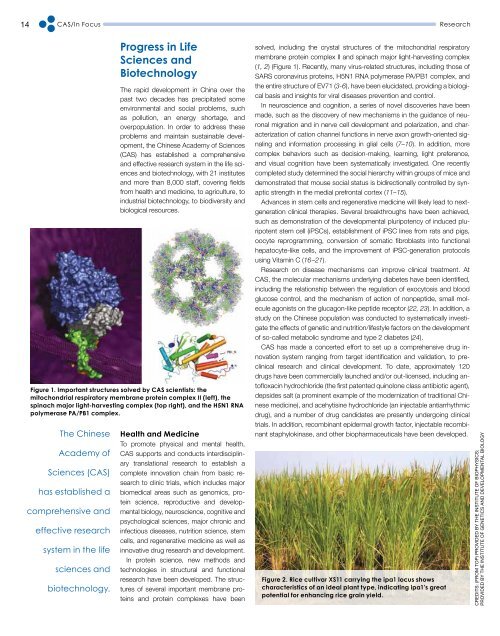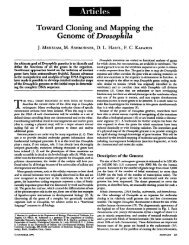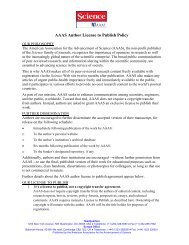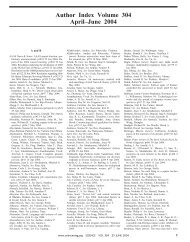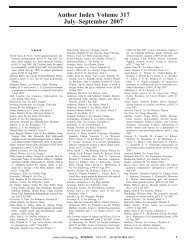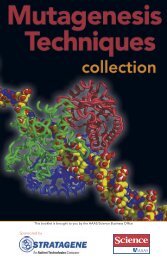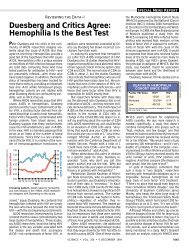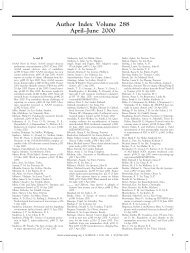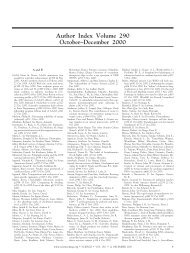Chinese Academy of Sciences (PDF) - low res version
Chinese Academy of Sciences (PDF) - low res version
Chinese Academy of Sciences (PDF) - low res version
Create successful ePaper yourself
Turn your PDF publications into a flip-book with our unique Google optimized e-Paper software.
14<br />
CAS/In Focus<br />
Prog<strong>res</strong>s in Life<br />
<strong>Sciences</strong> and<br />
Biotechnology<br />
The rapid development in China over the<br />
past two decades has precipitated some<br />
environmental and social problems, such<br />
as pollution, an energy shortage, and<br />
overpopulation. In order to add<strong>res</strong>s these<br />
problems and maintain sustainable development,<br />
the <strong>Chinese</strong> <strong>Academy</strong> <strong>of</strong> <strong>Sciences</strong><br />
(CAS) has established a comprehensive<br />
and effective <strong>res</strong>earch system in the life sciences<br />
and biotechnology, with 21 institutes<br />
and more than 8,000 staff, covering fields<br />
from health and medicine, to agriculture, to<br />
industrial biotechnology, to biodiversity and<br />
biological <strong>res</strong>ources.<br />
Figure 1. Important structu<strong>res</strong> solved by CAS scientists: the<br />
mitochondrial <strong>res</strong>piratory membrane protein complex II (left), the<br />
spinach major light-harvesting complex (top right), and the H5N1 RNA<br />
polymerase PA/PB1 complex.<br />
The <strong>Chinese</strong><br />
<strong>Academy</strong> <strong>of</strong><br />
<strong>Sciences</strong> (CAS)<br />
has established a<br />
comprehensive and<br />
effective <strong>res</strong>earch<br />
system in the life<br />
sciences and<br />
biotechnology.<br />
Health and Medicine<br />
To promote physical and mental health,<br />
CAS supports and conducts interdisciplinary<br />
translational <strong>res</strong>earch to establish a<br />
complete innovation chain from basic <strong>res</strong>earch<br />
to clinic trials, which includes major<br />
biomedical areas such as genomics, protein<br />
science, reproductive and developmental<br />
biology, neuroscience, cognitive and<br />
psychological sciences, major chronic and<br />
infectious diseases, nutrition science, stem<br />
cells, and regenerative medicine as well as<br />
innovative drug <strong>res</strong>earch and development.<br />
In protein science, new methods and<br />
technologies in structural and functional<br />
<strong>res</strong>earch have been developed. The structu<strong>res</strong><br />
<strong>of</strong> several important membrane proteins<br />
and protein complexes have been<br />
Research<br />
solved, including the crystal structu<strong>res</strong> <strong>of</strong> the mitochondrial <strong>res</strong>piratory<br />
membrane protein complex II and spinach major light-harvesting complex<br />
(1, 2) (Figure 1). Recently, many virus-related structu<strong>res</strong>, including those <strong>of</strong><br />
SARS coronavirus proteins, H5N1 RNA polymerase PA/PB1 complex, and<br />
the entire structure <strong>of</strong> EV71 (3-6), have been elucidated, providing a biological<br />
basis and insights for viral diseases prevention and control.<br />
In neuroscience and cognition, a series <strong>of</strong> novel discoveries have been<br />
made, such as the discovery <strong>of</strong> new mechanisms in the guidance <strong>of</strong> neuronal<br />
migration and in nerve cell development and polarization, and characterization<br />
<strong>of</strong> cation channel functions in nerve axon growth-oriented signaling<br />
and information processing in glial cells (7–10). In addition, more<br />
complex behaviors such as decision-making, learning, light preference,<br />
and visual cognition have been systematically investigated. One recently<br />
completed study determined the social hierarchy within groups <strong>of</strong> mice and<br />
demonstrated that mouse social status is bidirectionally controlled by synaptic<br />
strength in the medial prefrontal cortex (11–15).<br />
Advances in stem cells and regenerative medicine will likely lead to nextgeneration<br />
clinical therapies. Several breakthroughs have been achieved,<br />
such as demonstration <strong>of</strong> the developmental pluripotency <strong>of</strong> induced pluripotent<br />
stem cell (iPSCs), establishment <strong>of</strong> iPSC lines from rats and pigs,<br />
oocyte reprogramming, con<strong>version</strong> <strong>of</strong> somatic fibroblasts into functional<br />
hepatocyte-like cells, and the improvement <strong>of</strong> iPSC-generation protocols<br />
using Vitamin C (16–21).<br />
Research on disease mechanisms can improve clinical treatment. At<br />
CAS, the molecular mechanisms underlying diabetes have been identified,<br />
including the relationship between the regulation <strong>of</strong> exocytosis and blood<br />
glucose control, and the mechanism <strong>of</strong> action <strong>of</strong> nonpeptide, small molecule<br />
agonists on the glucagon-like peptide receptor (22, 23). In addition, a<br />
study on the <strong>Chinese</strong> population was conducted to systematically investigate<br />
the effects <strong>of</strong> genetic and nutrition/lifestyle factors on the development<br />
<strong>of</strong> so-called metabolic syndrome and type 2 diabetes (24).<br />
CAS has made a concerted effort to set up a comprehensive drug innovation<br />
system ranging from target identification and validation, to preclinical<br />
<strong>res</strong>earch and clinical development. To date, approximately 120<br />
drugs have been commercially launched and/or out-licensed, including ant<strong>of</strong>loxacin<br />
hydrochloride (the first patented quinolone class antibiotic agent),<br />
depsides salt (a prominent example <strong>of</strong> the modernization <strong>of</strong> traditional <strong>Chinese</strong><br />
medicine), and acehytisine hydrochloride (an injectable antiarrhythmic<br />
drug), and a number <strong>of</strong> drug candidates are p<strong>res</strong>ently undergoing clinical<br />
trials. In addition, recombinant epidermal growth factor, injectable recombinant<br />
staphylokinase, and other biopharmaceuticals have been developed.<br />
Figure 2. Rice cultivar XS11 carrying the ipa1 locus shows<br />
characteristics <strong>of</strong> an ideal plant type, indicating ipa1’s great<br />
potential for enhancing rice grain yield.<br />
CREDITS: (FROM TOP) PROVIDED BY THE INSTITUTE OF BIOPHYSICS;<br />
PROVIDED BY THE INSTITUTE OF GENETICS AND DEVELOPMENTAL BIOLOGY


